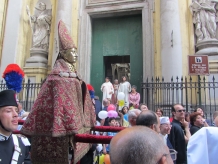Period Band B
Materiality, Holiness, Place: Baroque Art & Architecture
Tutor: Helen Hills
Description
In this module we reconsider approaches to baroque art and architecture, with careful attention to the extraordinary material possibilities of artworks and their implications for holiness and place. Our attention focuses on art and architecture made ca.1550-ca.1770 particularly in Rome and Naples. It approaches the baroque art work in terms of generational and operational capacities with wider potential and we examine this with careful attention to materiality. Thus the module draws on cutting-edge scholarship in art history, anthropology and philosophy to rethink baroque materiality in relation to holiness and place.
Objectives
At the end of this module students will have acquired:
- Critical capacity to interpret and analyse baroque art and architecture drawing on approaches encountered in the module.
- Alertness to and critical awareness of the operation of Italian baroque artworks
- Knowledge of up-to-date scholarship on materiality
- Knowledge and critical awareness of up to date scholarship on place, spatiality and locality
- Knowledge and critical awareness of scholarship on holiness.
- The capacity to read critically scholarship on artworks and to reflect analytically on assumptions about space, spatiality, locality and place.
Preliminary Reading
- Rose Marie San Juan, 'Contaminating Bodies: Print and the 1656 Plague in Naples', in M Calaresu & H Hills (eds), New Approaches to Naples c.1500-c1800, Ashgate: 2013, cap. 3, pp.63ff.
- Olson, Todd, ‘Caravaggio’s Coroner: Forensic Medicine in Giulio Mancini’s Art Criticism’, Oxford Art Jnl, 28.1, 2005, pp.83-98.
- Wendy Wassyng Roworth, ‘The Evolution of History Painting: Masaniello’s revolt and other disasters in 17thC Naples’, Art Bulletin, June 1993, vol. 75 n.2, 219-234.
- Christopher R Marshall, ‘ “Causa di stravaganze”: Order and anarchy in Domenico Gargiulo’s Revolt of Masaniello’, Art Bulletin, vol 80 n3 Sep 1998, 478-497.
- James Clifton, ‘Art and Plague at Naples’, in Hope and Healing. Painting in Italy in a Time of Plague, 1500-1800, eds. GA Bailey et al., Clark University, 2005, 97-117.
- Franco Mormando, ‘Introduction: response to the Plague in early Modern Italy: What the primary sources, printed and painted reveal’, in Hope and Healing. Painting in Italy in a Time of Plague, 1500-1800, eds. GA Bailey et al., Clark University, 2005, 1-44.
- Rose Marie San Juan, Rome. A City Out of Print, Minneapolis: University of Minnesota Press, 2001, Cap.7, ‘The Uncertainties of Time. Managing and Marketing the Plague of 1656-57’, 217-254.
- Katie Scott, ‘Figure & Ornament: Notes on the Late Baroque Art Industry’, in Taking Shape. Finding Sculpture in the decorative arts, Getty Museum: 2009, pp.166-176.
- Sandra Cavallo, Artisans of the Body in early modern Italy: Identities, families and masculinities (Manchester University Press: 2007), Cap. 2 'Health, beauty and hygiene: the broad domain of a barber-surgeon's duties', 38-63.
- Deleuze, Gilles, Le Pli, trans T Conley, The Fold: Leibniz and the Baroque, University of Minnesota Press, 1993.
- J. Connors, ‘Borromini's S. Ivo alla Sapienza: the spiral’, Burl Mag, vol.138, Oct 1996, pp.668ff.

Module Code HOA00049H
